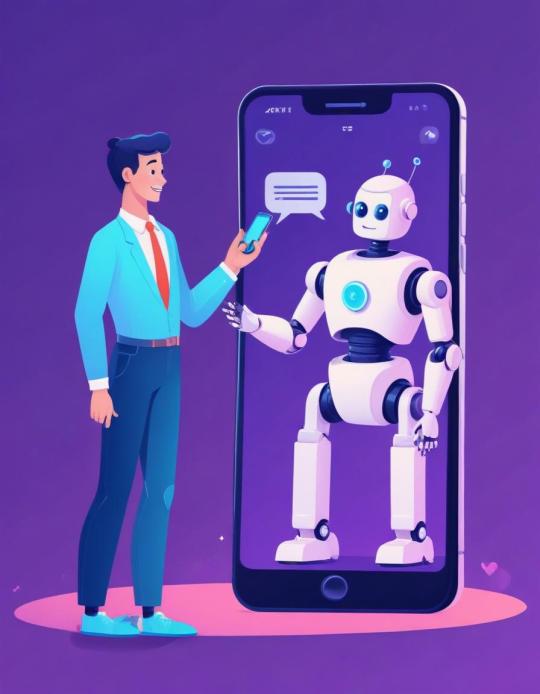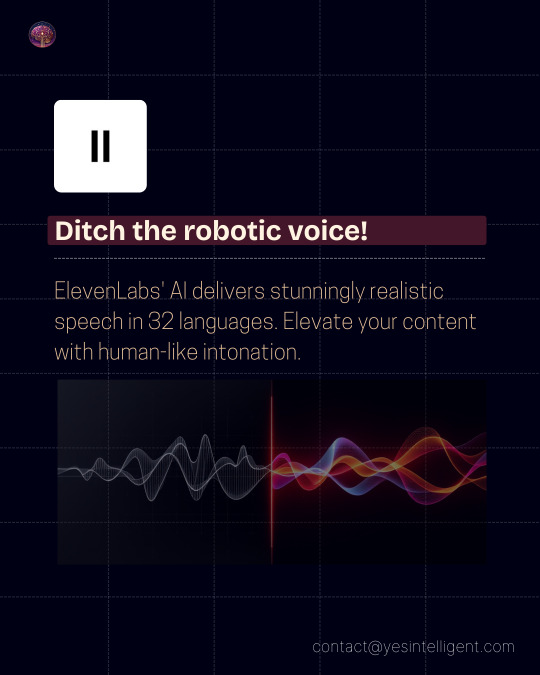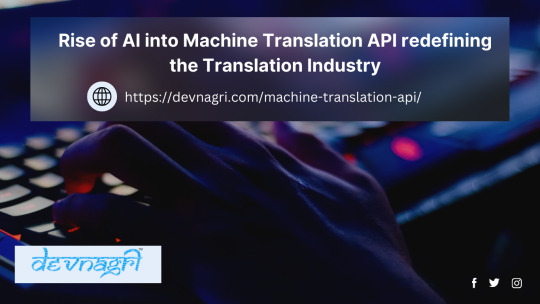#LanguageAI
Explore tagged Tumblr posts
Text
How to Improve the Accuracy of OCR Translation Tools?

Optical Character Recognition (OCR) technology got better and better over the past decade thanks to more elaborated algorithms, more CPU power,r, and advanced machine learning methods. Getting to OCR translation accuracy levels of 99% or higher is however still rather the exception and definitely not trivial to achieve.
We learned at Devnagri AI the hard way how to fine-tune our OCR engine to achieve good OCR accuracy and spent weeks fine-tuning our Image to Text Converter Online engine. So, if you are in the process of setting up an OCR solution and want to know how to increase the accuracy levels of your OCR engine, then keep on reading…
This blog talks about various techniques to enhance OCR accuracy and shares what we learn from building a world-class OCR system for Devnagri AI.
So, First, Let's Define OCR Translation Accuracy
Now when talking about OCR accuracy, there are two ways of measuring how reliable OCR is:
Accuracy on a character level: In most cases, the accuracy in OCR technology is gauged on a character level. The extent to which an OCR software is accurate on a character level is determined by how often it recognizes a character correctly and how often it recognizes a character incorrectly. A 99% accuracy means that 1 out of every 100 characters is uncertain. However, an accuracy of 99.9% means that 1 out of every 1000 characters is uncertain.
Accuracy on a word level: Most OCR translation engines use extra language knowledge about text to enhance their word-level accuracy. That is if the language is known where the text, for instance, is the English language, words recognized can then be compared to the dictionary of all extant words-for example, to all words in an English language corpus. Words containing uncertain characters can then be "fixed" by finding the word inside the dictionary with the highest similarity.
In this blog, we will focus on improving the accuracy of character level. The more accurate characters are recognized, the less "fixing" on a word level is required.
How to Increase Accuracy With OCR Translation Image Processing?
Assuming that you have already settled on an Image to Text Converter Online engine, we're now down to one single moving part in the equation to improve the accuracy of OCR:
Good Quality Original Source
Yes, we're repeating this on purpose! The very first simple step in obtaining precise OCR translation conversions is guaranteeing the good quality of the source images. First off, see that the original paper document does not contain tears, creases, or fading or was printed in poor contrasting color ink. In that case, outputting won't be clear enough. Use therefore the cleanest and the most original source of the file to convert.
Scaling To The Right Size
Make sure the images are at the appropriate resolution and are usually of at least 300 DPI (Dots Per Inch). Lowering DPI below 200 results in blurry and unclear images. A higher DPI of above 600 unnecessarily inflates the output file size but fails to improve the quality of the file. Therefore, 300 DPI is appropriate in this regard.
Increase Contrast
Low contrast can lead to poor OCR Translation. Increase the contrast and density before scanning. This can be done directly in the scanning software or any other image-processing software. Increasing the contrast of the text/image with its background brings out more clarity in the output.
Binarize Image
This is a step that converts a multicolored image (RGB) into a black-and-white image. There are several algorithms for converting a color image to a monochrome image, ranging from simple thresholding to more sophisticated zonal analysis.
What We Learned From Building The Devnagri AI OCR Pipeline?
When there is one thing learned about OCR accuracy, there is no silver bullet, and nothing is easier when it comes to shortcutting Image to Text Converter Online performance. You must inspect the documents carefully before attempting anything. Once you know your shortfalls, you can proceed to the applications of preprocessing steps as aforementioned to improve the accuracy of your OCR translation.
It is key to understanding how preprocessing works to tailor a preprocessing pipeline for the documents that you want to process. That's why we wanted to expose all preprocessing options to our users in Devnagri AI. Our default settings actually work well for most cases, but every preprocessing step can be tweaked according to the type of document that a user wants to process.
#OCRTranslation#OCRAccuracy#TranslationTechnology#AIinTranslation#LanguageRecognition#MachineLearning#TextRecognition#TranslationTools#OCROptimization#LanguageAI
0 notes
Text
The Future of Simultaneous Interpreting Services: AI vs. Human Interpreters

The landscape of simultaneous interpreting services is undergoing a significant transformation, driven by advancements in artificial intelligence (AI). Recently, a Tokyo-based public research institute under the Internal Affairs and Communications Ministry developed an AI capable of simultaneous interpretation with a natural conversational flow. Created by the National Institute of Information and Communications Technology (NICT), this AI is set to be deployed at the 2025 Osaka-Kansai Expo and is expected to be used in international negotiations by 2030. But how does AI stack up against human interpreters in this critical field? This article explores the comparison between AI and human interpreters, focusing on accuracy, tone and nuance, potential displacement of human interpreters, and the future trends of the industry.
Accuracy: The Core of Interpretation
Accuracy is very important in simultaneous interpretation, where the goal is to convey a speaker’s message with as little distortion as possible. Human interpreters have long been the gold standard, drawing upon their deep understanding of language, culture, and context to deliver precise translations. However, even the best interpreters can struggle under the immense pressure of real-time translation, occasionally leading to minor inaccuracies or omissions.
AI interpreters, on the other hand, benefit from vast databases of linguistic data and specialized glossaries, enabling them to deliver highly accurate translations. The AI developed by NICT, for example, was trained with the assistance of seasoned interpreters and can perform bidirectional interpretation in multiple languages, including Japanese, English, Chinese, Korean, and French. However, AI’s accuracy can still be limited by its programming, especially in complex or ambiguous contexts where cultural knowledge and human intuition are essential.
Tone and Nuance: The Human Element
One of the most significant challenges for AI in simultaneous interpreting is capturing the subtlety of tone and nuance. Human interpreters excel in this area, as they can understand the emotional undertones and cultural context behind words, adjusting their interpretation to reflect the speaker's intent accurately. This ability is crucial in diplomatic or high-stakes negotiations, where a slight misinterpretation could lead to misunderstandings or conflict.
AI, despite its advancements, still struggles to consistently interpret tone and nuance correctly. While it can recognize and replicate certain speech patterns, it often lacks the cultural and emotional intelligence that human interpreters bring to the table. For now, this remains a critical limitation of AI in the field of simultaneous interpretation.
Will AI Replace Human Interpreters Entirely?

The question of whether AI will eventually replace human interpreters is a topic of ongoing debate. AI’s rapid development suggests that it could handle a growing number of interpreting tasks, particularly in environments where speed and efficiency are prioritized over nuanced communication. In settings like large conferences or routine business meetings, AI interpreters may become the preferred choice due to their ability to process information quickly and consistently.
However, in situations where the stakes are high, and the need for cultural sensitivity is paramount, human interpreters are likely to remain indispensable. The subtle art of interpreting goes beyond word-for-word translation, requiring a deep understanding of context, tone, and intent—qualities that AI has yet to master fully.
Adapting to the Future: How Human Interpreters Can Thrive
As AI continues to evolve, human interpreters will need to adapt to maintain their relevance in the industry. This could involve working alongside AI to handle the more routine aspects of interpretation while focusing on the areas where human expertise is most needed. Interpreters may also need to develop specialized skills in interpreting complex and culturally sensitive material, positioning themselves as experts in areas where AI still falls short.
Moreover, ongoing professional development will be crucial. By staying up-to-date with technological advancements and continuously refining their linguistic and cultural knowledge, human interpreters can ensure they remain competitive in a rapidly changing field.
The Pros and Cons of AI in Simultaneous Interpreting
Pros:
Efficiency: AI can process and translate information quickly, making it ideal for fast-paced environments.
Consistency: AI provides consistent translations, free from the fatigue or stress that can affect human interpreters.
Scalability: AI can be deployed across multiple languages and regions simultaneously, offering broad accessibility.
Cons:
Lack of Cultural Sensitivity: AI often struggles with the nuanced understanding of cultural context and emotional tone.
Dependence on Data: AI's accuracy is heavily reliant on the quality and scope of its training data, which may not cover all linguistic subtleties.
Limited Adaptability: AI can struggle in unpredictable or highly complex situations where human intuition is required.

Future Trends: The Path Ahead
Looking ahead, the future of simultaneous interpreting services is likely to be a hybrid model where AI and human interpreters work together. AI will handle the bulk of straightforward translations, while human interpreters will be called upon for more intricate tasks that require a deep understanding of cultural context and emotional nuance. This collaboration could lead to more efficient and accurate interpretation services overall, combining the strengths of both AI and human expertise.
Additionally, as AI technology continues to improve, we may see the development of more sophisticated systems capable of better understanding and replicating human-like interpretation. This could further blur the lines between AI and human interpreters, creating a dynamic and evolving industry.
In conclusion, while AI is poised to play an increasingly important role in simultaneous interpreting services, human interpreters are far from obsolete. By embracing the opportunities presented by AI and focusing on areas where human skills are irreplaceable, interpreters can continue to thrive in a rapidly changing world.
#SimultaneousInterpreting#AIInterpreters#HumanInterpreters#InterpretingServices#AIvsHuman#TranslationTechnology#InterpretationAccuracy#LanguageServices#FutureOfInterpreting#AIInTranslation#CulturalSensitivity#MachineLearning#InterpreterSkills#LanguageAI#GlobalCommunication#AIInnovation#TechInLanguage#InterpreterLife#ConferenceInterpreting#MultilingualAI#TechAndHumanCollaboration#InterpretingFuture#AITranslation#NuanceInInterpreting#AIInConferences
0 notes
Text
How Machines Learn to Speak Our Language. Understanding NLP for dummies

Natural language processing (NLP) has come a long way since its inception in the middle of the 20th century. Without boasting, I'm a direct witness to the transformation of this field, and can testify to how far we've come from tiny, rule-based systems to today's most advanced artificial intelligence models. As well as changing the way machines understand and process human language, it has definitely changed the way we interact with tech.
The beginnings
It all started with fairly old-fashioned attempts to analyze and understand human language. And so was born the Georges-IBM experiment in 1954, which at the time was insane because it showed the potential that machine translation could have. Even though this experiment was limited in terms of technology or hardware, there were some nosy little investors who had a particular interest in NLP. And now that computing power is becoming monstrous, along with the evolution of language theories, NLP systems have been upgraded from rule-based approaches to stable methods in the 1980s and 1990s.
The language learning machine
Basically, NLP was just about machines understanding, interpreting and generating human language. And to achieve this process requires a very difficult analysis of syntax, semantics and pragmatics. These words may be difficult for the average person, but they are in fact the elements that make up linguistic understanding.Syntax

Syntax Tree – Natural Language Processing-GeeksforGeeks In fact, syntax is there only for the structure of language, looking at how words come together to form sentences. Natural language processing uses grammar to analyze sentences, looking at the parts of speech and how words relate to each other.Semantics

Semantic Features Analysis Definition, Examples, Applications - Spiceworks Inc Semantics is more about the meaning of words and sentences, so it enables machines to understand what is written in the text, and this level of understanding goes far beyond the way it is formed grammatically.Pragmatics

Pragmatics in NLP- Scaler Now, pragmatics takes context into account, which helps natural language processing systems to understand the meaning they are intended to convey, according to the situation at hand.I'd also like to point out that these components work together, enabling NLP systems to process language in a way that mimics the way humans use that language.
Digital linguists at work
Before NLPs can examine a text, the raw input must first be processed. This is an important step, as it transforms unstructured text into a format more suitable for automatic examination. Pre-processing text requires a number of techniques, each of which is important in preparing the data for NLP tasks.Tokenization

Understanding Tokenization in NLP!-WordPress.com Tokenization is often the first step, breaking down the text into smaller units called tokens. These can be words, phrases or even individual characters, I don't know, but it depends precisely on the NLP task. For example, I take the sentence "the dog sat on the sofa", you can see that it can be transformed into . So that's pretty much how it works.Lemmatization and steaming

Day 4: Stemming and Lemmatization- Nomidl Then there's stemming and lemmatization, which are techniques we use to reduce words to their original form. Stemming is a quick and simple process, a little crude you may say, and it cuts off the ends of words. For example, " running" becomes "to run".Lemmatization, on the other hand, uses morphological analysis to restore a word to the form it originally had in the dictionary. So, if you've understood, stemming may reduce "better" to "bet", but lemmatization will know perfectly well that "good" is its basic form.
Silicon polyglots
If you haven't already heard, machine translation has been the Holy Grail of NLP since its inception. The systems they had in the early days used direct translation, so they'd take a word, translate it, take another word, translate it and so on, often with funny results (I think that's how Google translation works, wouldn't you agree?). On the other hand, the translation systems we have today use highly sophisticated neural networks that are trained on large quantities of multilingual data, i.e. from several languages.And you and I both know that today's systems are capable of translating around a hundred languages with astonishing accuracy. They don't just translate word by word, like Google translation; they understand the context, they understand idiomatic expressions and they're able to maintain, as it were, the tone of the original text.But bof! There are always challenges to improving when it comes to understanding multiple languages. If there are languages with structures that are totally different, or if there is a lack of digital resources, this can pose problems. Researchers are therefore obliged to explore other techniques, such as learning from scratch and unsupervised machine translation, to improve on the challenges these systems will face.
Sentiment detectives

There's something called system analysis, and it's all about knowing the emotional tone of a text. So whether you want to analyze customer comments or gauge political opinion on social media, these sentiment analysis tools have become indispensable to businesses and organizations.You should know that these systems have evolved away from simple keyword-based approaches. Now they've become advanced models and can understand contrarianism, sarcasm and sentiments of all kinds. I'd also add that they can classify texts as positive, negative or neutral (if you're a blogger and use Rank math for your SEO, you'll notice that they give you a point when you use a positive or negative word in the title of your article) and there are even some systems that can detect specific emotions like anger, joy or surprise.I'd also like you to know that the applications are numerous. For example, companies are using sentiment analysis to monitor what people think of their brand, so they can improve customer service.For their part, financial institutions analyze market sentiment to predict stock market movements.And social media platforms use these tools to detect and hide the spread of negative or harmful content.
Question answering systems
Here, I'm going to talk about question answering (QA) systems. They used to be simple algorithms that allowed models to communicate with each other. Today, they understand and depend on complex requests. Previously, the only thing these systems did was limit themselves to specific domains and answers that had already been programmed, so they followed rules.Now, QA systems benefit enormously from deep learning and understanding natural language to process questions in context, search a vast library of knowledge and generate human-like answers. This is what powers Alexa and Siri, customer service chatbots and enterprise search tools.When transformer models like BERT and GPT were developed, they greatly improved the way quality assurance systems performed.
Chatbots and digital assistants
Let's face it, we've all been blown away by the evolution of conversational AI. Back in the 1960s, when the first chatbots like ELIZA were created, they used a then-trivial correspondence model to simulate conversations. But now, it's sophisticated NLPs that power these chatbots and digital assistants we have today. Not only can they understand context, they are also able to retain long-term memory and even adopt a kind of personality of their own.If we take customer service as an example, they're there to deal with routine inquiries, leaving human agents to concentrate on other things.If I take the field of healthcare, chatbots are able to provide simple symptom assessment and mental health support.And if I go to the education side, they can be used to help students answer their questions and offer personalized learning experiences. Unless those chatbots don't lose their marbles and tell the students some nonsense like these kidsUnless those chatbots don't lose their marbles and tell the students some nonsense like these kids
NLP in the wild
I'd like to delve a little deeper into what NLPs are capable of in healthcare. So, I'd like to mention that NLPs can analyze medical records, help with diagnosis and retrieve information from scientific literature.There are even legal professionals who use NLP tools to review contracts, and they are just as indispensable for carrying out due diligence and analyzing jurisprudence, i.e. the law or the constitution.I'm also thinking of finance, where NLPs power algorithmic trading systems that analyze news and social media to make investment decisions.Marketing teams use NLPs to make content better, so they analyze trends and personalize advertising.What's crazy and funny, and surprising at the same time, is that creative fields aren't leaving NLP behind. Like, it's used to generate content, it helps write automatic subtitles for videos.
The ubiquity of NLP
I myself have seen how NLP is developing, and how its presence in our everyday lives is only growing. If I remember correctly, last week, I smiled a little because I saw how to communicate with my smart home appliance in a totally ultra-fluid way. It was just crazy, it understood when I said to "dim the lights a bit" and I assure you I didn't give any other precise commands, it's just that, but it set the brightness to a level I liked I'd say COMFORTABLE, I was fine!!!Even in blogger work, I use them, for example Grammarly to correct grammar, and it also suggests style improvements, it helps me maintain a consistent tone and if I use for example Surfer SEO or Ahref, it sometimes helps me generate content ideas (I confess this article in fact I didn't have the idea, it came from Chatgpt, I wanted to test how generated content ideas, were they good? Did they have a medium level of competition? because often if you ask GPT to generate keywords with low competition it will generate keywords that have no competition at all, like a score of Zero)The impact of NLP on societyAccording to a report from Syracuse University, the impact of NLP on society is profound and far-reaching. The report states:NLP is used in AI chat bots and automated phone support to help diagnose issues without the need for a person in a call center. NLP is also used in automatic language transcription and translation, such as with automatic subtitles in YouTube. Researchers use NLP regularly to scrub websites for information and analyze that information for keywords or phrases. This report also says that NLP was born in 1906, when Swiss language professor Ferdinand de Saussure created several courses at the University of Geneva. In this course, it was said that language was like a system in which sounds were like concepts, and these concepts had meanings that changed according to context. This work, later published under the title Cours de Linguistique Générale, (General linguistics course in English ) laid the foundations for what we know today as NLP.According to Syracuse university In the future, we'll (perhaps) have machines that pass the Turing test with flying colors, and if all goes well, we'll also have better real-time translation of speech and text.
Conclusion
Chatterbox, I know this article has been long and I apologize for that, I hope if you've made it this far it's because you're dying to know about Natural language processing or you're a technophile. But thank you for reading this far and I'll leave you saying that I totally agree that NLP will continue to improve our world, whether in communication or to enable more natural interactions with AIs, but if it's developed irresponsibly without taking into account privacy, prejudice and the impact on society, there will be a serious problem. At the same time, I'm discovering how ingenious humans are, and how they're always trying to make machines understand better. It's totally interesting! Read the full article
#AIandlanguage#AIinlanguage#AIlanguagemodels#DeeplearningforNLP#FutureofNLP#HistoryofNLP#LanguageAI#Languageprocessingtechnology#MachinelearninginNLP#ModernNLPapplications#NaturalLanguageProcessing#Naturallanguageunderstanding#NLPadvancements#NLPapplications#NLPevolution#NLPimpactonindustries#NLPinAI#NLPtechniques#NLPtools#NLPtrends
0 notes
Photo

~ai? i midzdz usu msiaie tnai aiutning ii tnidz osia?~ Unlock the whimsical world of Pinterest and let your creativity soar.
0 notes
Photo

~ai? i midzdz usu msiaie tnai aiutning ii tnidz osia?~ Unlock the whimsical world of Pinterest and let your creativity soar.
0 notes
Text
~ai? i midzdz usu msiaie tnai aiutning ii tnidz osia?~

Ready to dive into the playful paradise of Pinterest? Get ready to
0 notes
Text
Meet the Machines That Think for Themselves: AI Agent Development Explained
Here is your full 1500-word blog post titled:
Meet the Machines That Think for Themselves: AI Agent Development Explained

For decades, artificial intelligence (AI) has largely been about recognition—recognizing images, processing language, classifying patterns. But today, AI is stepping into something more profound: autonomy. Machines are no longer limited to reacting to input. They’re learning how to act on goals, make independent decisions, and interact with complex environments. These are not just AI systems—they are AI agents. And they may be the most transformative development in the field since the invention of the neural network.
In this post, we explore the world of AI agent development: what it means, how it works, and why it’s reshaping everything from software engineering to how businesses run.
1. What Is an AI Agent?
At its core, an AI agent is a software system that perceives its environment, makes decisions, and takes actions to achieve specific goals—autonomously. Unlike traditional AI tools, which require step-by-step commands or input prompts, agents:
Operate over time
Maintain a memory or state
Plan and re-plan as needed
Interact with APIs, tools, and even other agents
Think of the difference between a calculator (traditional AI) and a personal assistant who schedules your meetings, reminds you of deadlines, and reschedules events when conflicts arise (AI agent). The latter acts with purpose—on your behalf.
2. The Evolution: From Models to Agents
Most of today’s AI tools, like ChatGPT or image generators, are stateless. They process an input and return an output, without understanding context or goals. But humans don’t work like that—and increasingly, we need AI that collaborates, not just computes.
AI agents represent the next logical step in this evolution: PhaseCharacteristicsRule-based SystemsHardcoded logic; no learningMachine LearningLearns from data; predicts outcomesLanguage ModelsUnderstands and generates natural languageAI AgentsThinks, remembers, acts, adapts
The shift from passive prediction to active decision-making changes how AI can be used across virtually every industry.
3. Key Components of AI Agents
An AI agent is a system made up of many intelligent parts. Let’s break it down:
Core Brain (Language Model)
Most agents are powered by an LLM (like GPT-4 or Claude) that enables reasoning, language understanding, and decision-making.
Tool Use
Agents often use tools (e.g., web search, code interpreters, APIs) to complete tasks beyond what language alone can do. This is called tool augmentation.
Memory
Agents track past actions, conversations, and environmental changes—allowing for long-term planning and learning.
Looped Execution
Agents operate in loops: observe → plan → act → evaluate → repeat. This dynamic cycle gives them persistence and adaptability.
Goal Orientation
Agents aren’t just reactive. They’re goal-driven, meaning they pursue defined outcomes and can adjust their behavior based on progress or obstacles.
4. Popular Agent Architectures and Frameworks
AI agent development has gained momentum thanks to several open-source and commercial frameworks:
LangChain
LangChain allows developers to build agents that interact with external tools, maintain memory, and chain reasoning steps.
AutoGPT
One of the first agents to go viral, AutoGPT creates task plans and executes them autonomously using GPT models and various plugins.
CrewAI
CrewAI introduces a multi-agent framework where different agents collaborate—each with specific roles like researcher, writer, or strategist.
Open Interpreter
This agent runs local code and connects to your machine, allowing more grounded interaction and automation tasks like file edits and data manipulation.
These platforms are making it easier than ever to prototype and deploy agentic behavior across domains.
5. Real-World Use Cases of AI Agents
The rise of AI agents is not confined to research labs. They are already being used in practical, impactful ways:
Personal Productivity Agents
Imagine an AI that manages your schedule, drafts emails, books travel, and coordinates with teammates—all while adjusting to changes in real time.
Examples: HyperWrite’s Personal Assistant, Rewind’s AI agent
Enterprise Workflows
Companies are deploying agents to automate cross-platform tasks: extract insights from databases, generate reports, trigger workflows in CRMs, and more.
Examples: Bardeen, Zapier AI, Lamini
Research and Knowledge Work
Agents can autonomously scour the internet, summarize findings, cite sources, and synthesize information for decision-makers or content creators.
Examples: Perplexity Copilot, Elicit.org
Coding and Engineering
AI dev agents can write, test, debug, and deploy code—either independently or in collaboration with human engineers.
Examples: Devika, Smol Developer, OpenDevin
6. Challenges in Building Reliable AI Agents
While powerful, AI agents also come with serious technical and ethical considerations:
Planning Failures
Long chains of reasoning can fail or loop endlessly without effective goal-checking mechanisms.
Hallucinations
Language models may invent tools, misinterpret instructions, or generate false information that leads agents off course.
Tool Integration Complexity
Agents often need to interact with dozens of APIs and services. Building secure, resilient integrations is non-trivial.
Security Risks
Autonomous access to files, databases, or systems introduces the risk of unintended consequences or malicious misuse.
Human-Agent Trust
Transparency is key. Users must understand what agents are doing, why, and when intervention is needed.
7. The Rise of Multi-Agent Collaboration
One of the most exciting developments in AI agent design is the emergence of multi-agent systems—where teams of agents work together on complex tasks.
In a multi-agent environment:
Agents take on specialized roles (e.g., researcher, planner, executor)
They communicate via structured dialogue
They make decisions collaboratively
They can adapt roles dynamically based on performance
Think of it like a digital startup where every team member is an AI.
8. AI Agents vs Traditional Automation
It’s worth comparing agents to traditional automation tools like RPA (robotic process automation): FeatureRPAAI AgentsRule-basedYesNo (uses reasoning)AdaptableNoYesGoal-drivenNo (task-driven)YesHandles ambiguityPoorlyWell (via LLM reasoning)Learns/improvesNot inherentlyPossible (with memory or RL)Use of external toolsFixed integrationsDynamic tool use via API calls
Agents are smarter, more flexible, and better suited to environments with changing conditions and complex decision trees.
9. The Future of AI Agents: What’s Next?
We’re just at the beginning of what AI agents can do. Here’s what’s on the horizon:
Agent Networks
Future systems may consist of thousands or millions of agents interacting across the internet—solving problems, offering services, or forming digital marketplaces.
Autonomous Organizations
Agents may be used to power decentralized organizations where decisions, operations, and strategies are managed algorithmically.
Human-Agent Collaboration
The most promising future isn’t one where agents replace humans—but where they amplify them. Picture digital teammates who never sleep, always learn, and constantly adapt.
Self-Improving Agents
Combining LLMs with reinforcement learning and feedback loops will allow agents to learn from their successes and mistakes autonomously.
10. Getting Started: Building Your First AI Agent
Want to experiment with AI agents? Here's how to begin:
Choose a Framework: LangChain, AutoGPT, or CrewAI are good places to start.
Define a Goal: Simple goals like “send weekly reports” or “summarize news articles” are ideal.
Enable Tool Use: Set up access to external tools (e.g., web APIs, search engines).
Implement Memory: Use vector databases like Pinecone or Chroma for contextual recall.
Test in Loops: Observe how your agent plans, acts, and adjusts—then refine.
Monitor and Gate: Use human-in-the-loop systems or rule-based checks to prevent runaway behavior.
Conclusion: Thinking Machines Are Already Here
We no longer need to imagine a world where machines think for themselves—it’s already happening. From simple assistants to advanced autonomous researchers, AI agents are beginning to shape a world where intelligence is not just available but actionable.
The implications are massive. We’ll see a rise in automation not just of tasks, but of strategies. Human creativity and judgment will pair with machine persistence and optimization. Entire business units will be run by collaborative AI teams. And we’ll all have agents working behind the scenes to make our lives smoother, smarter, and more scalable.
In this future, understanding how to build and interact with AI agents will be as fundamental as knowing how to use the internet was in the 1990s.
Welcome to the age of the machines that think for themselves.
0 notes
Photo

ElevenLabs AI: Unleash Realistic Voice Technology in 32 Languages #ad #VoiceAI #AISpeech #ElevenLabs #RealisticVoice #LanguageAI #SpeechTech
0 notes
Text
Did you know about the limitations of ChatGPT?
We all know that #AI tools can help simplify customer service and reduce human labor. But do you know their limitations?
Here are a few things to keep in mind when interacting with this powerful language model. #ChatGPT #LanguageModel #AI"







#Chatbot#AI#NLP#LanguageModel#Technology#Innovation#Automation#DigitalTransformation#AIchatbot#LanguageAI#AIassistant#ConversationalAI
0 notes
Text
Rise of AI into Machine Translation API redefining the Translation Industry
Understanding the new era of artificial intelligence backed by machine learning is complicated. Machine translation is also on the trend utilizing the latest technologies available out there. Companies specifically large enterprises and SMBs are using machine translation API ensuring high accuracy and scalable content. Even government organizations in the management and security as well are into a lot of translation.
At the pace at which AI is developing, we can look at the future easily. Even the news is older about training neural networks on computers to store information and make it available customized and filtered as per requirement. These networks are backed by generative AI but still make mistakes because these networks still cannot be analyzed at a certain human level.
Still, large organizations are processing their operations with a combination of artificial and human-based intelligence. Undeniably, our machine can not start thinking like human beings suddenly but these tools are still on the training model.
Now if we talk about the translation industry, Machine Translation APIs come into the game where these tools use the generative API and are on tegular training backed by machine learning as discussed in the introduction at the beginning of this blog.
Now what’s new with machine translation APIs during the rise of AI in the market
Size Matters
Now size also matters with an increase in requirements of the translation content in sort of types including the visuals, audios, and videos as well apart from the text. Organizations are translating the contexts not only into official or most popular languages.
Also, the local dialects to localize their content as well as the business. Training and manipulating the data is part of training models which is important to build a database empowering the robust functionalities into the machine translation API.
Speed is Everything
Now speed is everything in this fast-forward era, here people compete on speed. No one has time, technology is moving forward at a pace that couldn’t have been imagined a few decades back. Every day is something new out there in terms of content in the market.
Now Generative AI tools in the market whether they are paid or free, no one has a monopoly in the market they all are facing competition. Every giant across the globe has its own AI for the users.
Changes to The Translation Industry
The question arises that the whole will think about the business looking to localize their business in the market.
Who is sitting to customize the services for their business according to the use case? Also, the people residing deep in the different regions of the world almost everyone is using the internet but everyone is not contributing to it.
Moreover, most of the content is in English over the content. How the local people will access that content until and unless they know the international English Language?
Summing Up
Far from the large language models here comes the small language models and machine translation APIs that support the website translation and app translation in terms of multiple languages helping the companies to reach their users and distribute their services at a vast level.
Not only the product and service market but also the market that supports education, hospitality, banking, business, government, security, e-commerce, and media. Keep reading for more.

#AITranslation#MachineTranslation#AIinTranslation#TranslationTechnology#LanguageAI#TranslationInnovation#FutureOfTranslation#AIRevolution#TechInTranslation#SmartTranslation
0 notes